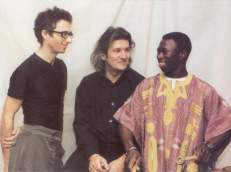
Slonovina, jak zní v překladu název tria, je cenný materiál. Považujeme
ho za vzácný a obdivujeme slona, kterému za něj vděčíme. Používá se mimo
jiné na klávesy kvalitních klavírů. A Pobřeží slonoviny je název jedné
z největších a nejdůležitějších zemí západní Afriky.
Německý pianista Hans Lüdemann je ve spojení s Afrikou už dlouho. Jeho
kompozice a improvizace jsou inspirovány africkou hudbou. Během svého
turné v západní Africe strávil dva týdny na Pobřeží slonoviny. V projektu
Goethe Institutu, který se uskutečnil v Abidjanu, se setkal s Aly Keitou,
velkým mistrem balafonu. Na společné premiéře pak spolu s velkým úspěchem
zahráli. Na podzim 1999 byl Lüdemann pozván ke spolupráci s Keitou
do Abidjanu opět. Koncem tohoto roku založili v Kolíně nad Rýnem Trio Ivoire
a nahráli program pro rozhlas (WDR) a první CD.
Třetím členem velice rytmického tria se stal vynikající anglický bubeník
Steve Argüelles, žijící v Paříži.
Trio slavilo svůj první velký úspěch v místech, kde se jeho hudba zrodila:
V červnu 2000 hrálo na Pobřeží slonoviny při příležitosti třicátého
výročí založení Goethe Institutu v Abidjanu. V srpnu 2000 debutovalo
trio úspěšně v Německu na koncertu pro Expo 2000 v Hannoveru.
Je těžké popsat slovy energii a charisma Aly Keity. On a jeho protějšek
Lüdemann jsou spřízněné duše, které se našly navzdory kulturním
hranicím. Argüelles spolupracuje s Lüdemannem už deset let. Perkusista
doplňuje barvy piana a balafonu rytmickým žárem a svéráznými nápady. Trio
využívá také elektronické nástroje, které zajímavě kontrastují
s akustickými. Výsledkem toho všeho je zvláštní druh world music, vzdálený
stereotypům a klišé.
Balafon je považován za druh našeho xylofonu či marimby. Díky svým
klávesám má blízko k pianu. V Africe se ostatně někdy říká pianu "tubabo
balafola", balafon bílého muže. Lüdemann využívá tohoto zvláštního vztahu
ve skladbě "Le balaphon blanc et noir" (Černý a bílý balafon). Jako mnoho
dalších, také tato byla napsána speciálně pro Trio Ivoire. V kompozicích
se mísí různé tonality, africký smysl pro rytmus a dlouhé pasáže volných
improvizací. Některé se pohybují v konvencích harmonických tradic, jiné
tvoří polytonalitu a nechávají tak balafonu dobře vyniknout. Jinde naopak
dodává balafon pianu temné a zemité zabarvení. Čistá radost z hudby,
nekonečná škála nápadů a variací a udivující rytmické triky jsou pro
Trio Ivoire charakteristické, zažijete s ním podivuhodný hudební výlet.
CD Trio Ivoire RISM - edition (2001)
Ivory is a valuable material. We estimate it as a treasure and we admire the
animal giving us the ivory - the elephant. It is used as the material for the
keys of high-quality grand pianos. Ivory Coast is the name of one of the most
important and biggest countries in West-Africa.
The German pianist Hans Lüdemann has been in touch with Africa for a long time.
His compositions and improvisations are inspired by African music. During his
tour through West-Africa in 1999 he stayed for two weeks in Ivory Coast. In a
project of the Goethe Institute in Abidjan he met Aly Keita, one of the greatest
vituoso players of the balaphon. Their concert premiere became a great sucess.
In autumn of 1999, Lüdemann was invited to come again to Abidjan to continue his
cooperation with Aly Keita. At the end of 1999, Lüdemann and Keita founded the
"Trio Ivoire" in Cologne / Germany and recorded a radio production for WDR and
their first CD production. As the third musician of this very rhythmic trio they
chose one of the most exciting European drummers: Steve Argüelles, an Englishman
who lives in Paris.
The Trio Ivoire celebrated its first great sucess where the remarkable music
project was born: In June of 2000 the three musicians played in Ivory Coast for
the 30th anniversary of the Goethe Institute in Abidjan. In August 2000 the trio
made its sucessful debut in Germany with a concert at the EXPO 2000 in Hannover.
It is hard to match the energy and charisma of Aly Keita. He and his counterpart
Lüdemann are "soul mates" who have found each other across cultural boundaries.
Argüelles has been working with Lüdemann on and off for 10 years. The
percussionist completes the colours of piano and balaphon with his rhythmic
fire, his timbres and special ideas. Lüdemann and Argüelles also make use of
electronic sounds in contrast with the acoustic instruments. The result of all
these different colours is a special kind of world music, away from stereotypes
or clichés - a play between traditions, visions and experiments.
The balaphon is regarded as the model of our xylo- and marimbaphon. Because of
its keys there is a close relation to the piano. In fact, the piano in Africa is
sometimes called "tubabo balafola", the balaphon of the White man. Lüdemann
picks up this special relationship in his composition "Le balaphon blanc et
noir". Like most other pieces, this one has been especially written for the Trio
Ivoire. In this composition there is a blend of different tonalities, an African
feeling of rhythm and freely designed long passages of improvisation. Some
compositions keep within the limits of harmonic traditions, others create poly
tonality and thus let the balaphon appear in a different light. In turn, the
sound of the balaphon adds to the piano a dark and earthy timbre. With pure joy
of playing, an endless flow of ideas and variations and dumbfounding rhythmic
tricks Trio Ivoire takes us on a long journey.